| |
Mods To My Bolger-Designed Cartoppers
That can be adapted to other
boats
by John
O'Neill
I built two Phil Bolger-designed Cartoppers and have
sailed them regularly in varied conditions for five years.
For those unfamiliar they are 11.5' by 4'3" two-chine,
narrow-bottom plywood craft that can be sailed, rowed and
motored, and are docile when towed.
Over the years I've come up with some solutions to
problems with the boat (both real and imagined) some of
which may be of interest not only to other Cartopper sailors,
but to small boat sailors in general . . . .
RIG MODS
Sail:
My Cartoppers have a Marconi
sprit-boom rig (Bolger's plans also show a sprit rig, handy
for being able to stow all spars inside the boat). Bolger
didn't draw in reef points for either rig, and shows the sails
laced to the mast (no halyard). I put reef points in anyway,
along the foot of the sail.
As it turns out Cartoppers
balance and handle better when reefed (a by-product of their
far-forward centerboard).
.jpg)
Pic 1 - The clam cleat at the masthead. It might not
look it but the halyard is slack and waving around.
In practice I cleat it off as usual, but with next to
no tension on it. |
Halyard:
But - and this is a big but
- adding a halyard, necessary for reefing, adds significant
stress to the mast. Since the mast wasn't supposed to have
a halyard Bolger sized it small (the bending mast spills some
breeze when it comes on). To mitigate the resulting large
amount of bend I encountered with a halyard, I took a page
from some racers' handbooks and added an open-type clam cleat
to the masthead, in way of the halyard (see photo).
My first time out with the
mod I noticed a _huge_ difference in mast bend. It's a mod
that is easily adapted to any number of small craft, and especially
on unstayed rigs might be a good idea as a general practice.
The halyard easily pulls out from the clam cleat by holding
it at arm's length and tugging, and is just as easily cleated
by lining up the halyard and pulling down on the sail.
Snotter:
All the small craft sprit-boom
rigs I've seen have only one "snotter" (the line
attached to the mast that holds up the forward end of the
sprit boom). And indeed many small-boat snotters are more
or less permanently rigged. Once set-up at the dock they stay
that way for the duration of the sail. They're called "adjustable,"
but that's like calling the old-fashioned, tube-type televisions
that came with a handle on top "portable" - once
you wrestled it into place you didn't want to have to move
it again.
Rigging the snotter in such
a fashion eliminates one of the main advantages of the sprit-boom
rig, that is, the ability to widely adjust the set of the
sail. A fully adjustable snotter is, in effect, a traveler,
boomvang and outhaul all in one.
To take advantage of the possibilities
I eventually rigged not one, but two snotters to the sprit
boom of my Cartoppers, an up-haul and down-haul that work
in tandem to control the vertical and horizontal position
of the sprit boom in relation to the mast, and ran both lines
aft where I can easily adjust them.
In light airs I can, for example,
lower the sprit to relax the leech and ease it to add draft.
In medium airs I can raise it vertically to close up the leech
while still having enough draft. In heavier air I can raise
it high to close the leech and bear down on it to lessen the
draft (taken to the extreme that actually results in "pre-bending"
the mast, just as in hi-tech racing dinghies - although to
not nearly so extreme a degree).
If it really starts blowing
and I'm having trouble keeping the boat upright I can keep
tension on the snotters to lessen draft while lowering the
sprit to open the leech and spill big gobs of that breeze
(a very nice feature!). Opening the leech also works well
- in any sailing craft - in shifty, gusty conditions and in
waves, when having an open leech helps to keep at least some
portion of the sail drawing properly at all times.
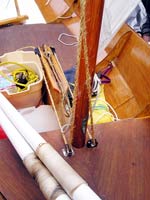 Pic
2 (click to enlarge) - The snotter - up-haul and down-haul:
The attachment to the mast is set much higher than it
would be for a single-snotter arrangement, to allow for
a wider variation in the vertical position of the boom.
Here the boom is all the way up and pulled taut. There
is next to no tension on the sheet, but notice the pre-bend
in the mast, pulling draft from the luff. One other thing
to note is the lack of lacing immediately above the snotter
attachment (the lacing is per Payson, individual loops
of line tied to itself at the front of the mast, rather
than one continuous lacing - and it works GREAT). With
that single loop missing I can reef without having to
remove and re-reeve the snotters. One of these days I
may just remove every second lacing loop, because the
loops next to one another seem redundant, and all of them
too-easily catch on the mast-mounted snotter attachment
ears when raising sail. Pic
2 (click to enlarge) - The snotter - up-haul and down-haul:
The attachment to the mast is set much higher than it
would be for a single-snotter arrangement, to allow for
a wider variation in the vertical position of the boom.
Here the boom is all the way up and pulled taut. There
is next to no tension on the sheet, but notice the pre-bend
in the mast, pulling draft from the luff. One other thing
to note is the lack of lacing immediately above the snotter
attachment (the lacing is per Payson, individual loops
of line tied to itself at the front of the mast, rather
than one continuous lacing - and it works GREAT). With
that single loop missing I can reef without having to
remove and re-reeve the snotters. One of these days I
may just remove every second lacing loop, because the
loops next to one another seem redundant, and all of them
too-easily catch on the mast-mounted snotter attachment
ears when raising sail. |
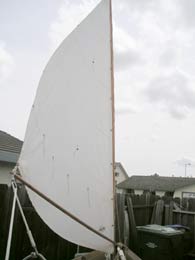 |
|
| Pics 3 & 4 - The first
shot shows the boom extremely low with little tension
on the snotter. Despite the very light breeze the clew
has lifted, opening the leech. In a breeze this same effect
can be had with the boom much higher, depending on how
tight the snotters are. The second pic (for which I had
to stand poised, ready to take the shot, for about 5 minutes
while waiting for a good gust to fill the sail, which
otherwise looked insipid) shows the sprit at a normal
position with moderate tension. The leech is closed up
nicely. Note the tension on the foot of the sail, keeping
the clew from rising (and the leech from opening) in the
gust. It should be noted that the effects on sail trim
of changing vertical position and tension on a sprit-boom
tend to overlap each other (making it a less than perfect
system for say, racers). Easing tension allows more draft,
which itself allows the clew to lift even if boom vertical
position is held fixed. Also in this up-haul, down-haul
method a pull on either line effects both the vertical
position of the boom and the draft of the sail simultaneously
(it's a failing of the system), which makes fine-adjustments
to either one alone extremely difficult. That said, it's
a Cartopper, not a Thistle or a Star, and it works quite
well indeed anyway, thank you very much! |
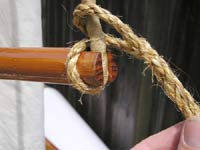 Pic
5 (click to enlarge) - Detail shot of the forward end
of the sprit-boom, showing how I rig the two snotters.
Both are eye-spliced to just fit around the boom. The
splice portion of the up-haul is an interference fit with
the slot in the boom, keeping all in place even when everything
is slack and flailing about. Pic
5 (click to enlarge) - Detail shot of the forward end
of the sprit-boom, showing how I rig the two snotters.
Both are eye-spliced to just fit around the boom. The
splice portion of the up-haul is an interference fit with
the slot in the boom, keeping all in place even when everything
is slack and flailing about. |
Pic
6 (click to enlarge) - More snotter rigging detail. Port
side is down-haul, starboard side is up-haul. The boom
here is well off to 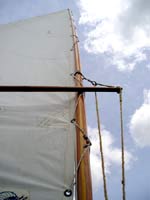 port.
The up-haul can be rigged through a turning block because
it's relative position doesn't change tack to tack; it
always leads straight down the mast. The down-haul, however,
leading as it does directly from the end of the boom,
describes a wide arc from one tack to another - hence
the bulls-eye. The theory behind using manilla line (other
than that it's cheap and easily spliced) is that - I hope
- it will stretch and, it is further hoped, be the first
thing to break in a case where, with snotters taut, the
sheet gets away and the sail/mast/boom rotates all the
way round the boat! port.
The up-haul can be rigged through a turning block because
it's relative position doesn't change tack to tack; it
always leads straight down the mast. The down-haul, however,
leading as it does directly from the end of the boom,
describes a wide arc from one tack to another - hence
the bulls-eye. The theory behind using manilla line (other
than that it's cheap and easily spliced) is that - I hope
- it will stretch and, it is further hoped, be the first
thing to break in a case where, with snotters taut, the
sheet gets away and the sail/mast/boom rotates all the
way round the boat! |
Mast:
I made my mast round and somewhat
loose in the step, which allows it to rotate. This is a very
handy feature for sprit-boom rigs. Especially with the snotter
taut it allows the entire mast-boom arrangement to turn as
a unit.
If a sprit boom is forced to
rotate separately from the mast the snotter(s) slacken or
tighten depending on which way it's moving, because a standard
sprit-boom is offset from centerline. Ideally the snotters
in a rotating mast rig should attach to the mast. Mine are
led aft, but as led there is actually little change in snotter
tension as the boom/mast turns, unless it turns a lot, as
happens downwind if the sheet is let go and the sail ends
up turned around backwards (making for an odd-looking boat!).
OTHER MODS:
Flotation:
This mod, instituted out of
complete ignorance, was a huge failure - and it wasn't me
who had to pay the price. . .
I'd installed flotation under
the mid-ships platform in one of my two Cartoppers. I thought
I was doing my brother a favor by giving him the "flotation"
boat one typically breezy, gusty, shifty day in the Suisun
Slough in the delta area of the San Francisco Bay.
Bad idea.
A big, shifting gust hit him
downwind towards the end of the day. He gybed unexpectedly
and went over. Knowing he had flotation I didn't think he'd
have a huge problem if we could just get him back in the boat.
Silly me.
The flotation, located
low in the boat, worked against him and badly.
Despite all his efforts (and he's a big guy) to keep the boat
upright as soon as the boat got a little bit sideways the
flotation pushed and pushed and pushed against him until she
was floating on her side, and then continued to push, push
push to turn everything turtle.
This happened twice, once with
the mast stepped, once with the mast unstepped. He ended up
having to kick the boat to the bank, wedge it up against a
mud wall and after nearly an hour of bathing in the muddy
slough he was back aboard with a dry craft (if not dry clothes).
It took another 30 minutes for him (unfamiliar as he was with
the thing, and now shivering) to sort out the tangled rig,
step the mast, reef, and raise sail.
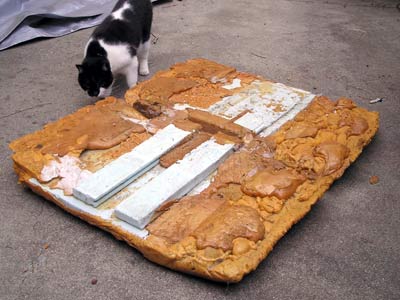
Pic 7 - The evil flotation, in the shape
of the area under the mid-ships platform (cat for scale).
The dark color is the result of about three years sitting
outside in the sun, unwanted, leaning against a fence.
He's a great sport and considered
it a fine adventure (even the part where I, sailing past at
high speed in the rising wind, threw him a bailing bucket
only to have it knock him squarely on the head!). He only
lamented the loss of his cell phone - the second one so far
that's he's sacrificed to the gods of the Suisun Slough.
It can happen. I've had it
happen. The first time it took me an embarrassingly
long time to figure out how it was that the sheet had somehow
got itself wrapped around the forward end of the mast! The
single snotter was cleated to the mast at the time, as Bolger
shows it (back in those sweet, by-gone, brand-new-boat days),
so it's lead wasn't an issue (a distinct advantage of securing
it that way). I managed to re-rig the sheet and was actually
on my way home - in the car (!) - before I figured out that
it wasn't weird science or black magic that wrapped that sheet
backward. Rather, I'd lost the sheet downwind in a breeze
bigger than (neophyte) I should have been out in (big panic
moment) - resulting in a sail all the way forward (er, backwards)
- and that inadvertently I'd turned the boat the wrong way
round to recover (it was already turning that way anyway,
so I just kept going). So the sail/mast/boom basically did
a 360 relative to the boat wrapping sheet around the mast.
(Or maybe it was the boat that did a 360 relative to the sail?
I don't know. We might have to consult the special theory
of relativity, because it sure did seem to happen at light
speed anyway!). One way or the other it was a lesson hard-learned,
one I'll not forget, and the upshot is, those aft-led leads
are natural-fiber and they're staying that way.
A mod I haven't done:
Slab reefing!
I have a scheme, a plan, a
dream: being able to reef my boat at sea! What a concept .
. .
Plan: Rig a turning block arrangement
on the end of the boom to be able to quickly haul the reef
clew down to the boom, and a similar arrangement for the tack.
I'll be able to tie the reef points up at leisure, or maybe
rig some lacing line arrangement.
But what about the halyard?
It's far forward at the mast and difficult to get at solo
in a breeze without risking a swim.
Well, I have a clam cleat.
I can leave the halyard slack, but cleated at a pre-determined
point that allows the sail to come down just the right amount
for reefing. To get it out of the clam cleat the scheme involves
a line tied around the slack part of the halyard and led into
the cockpit somewhere, that I can give a nice strong pull
on to release the halyard from the cleat. Down comes the sail,
but not all the way because it is cleated at just the right
point for the reef! I pull on the tack reefing line to cinch
things up, tie in the reef points, and I'm done!
- John O'Neill -

|
|
| Featuring
|
| |
Plans
 |
| |
| |
| |
|
|
|
Books

|
| |
Magazines

|
| |
| |
Chandlery

|
| |
|
|
|
| |
|
|
|
| |
|
|
|
|
| |
Sail
Loft

|
|
|
|
|
|
|
CDs
 |
| |
Wearables
 |
| |
| |
| |
Fun
Stuff

|
| |
|
| d |
|

